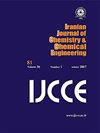Removal of Phenol by Expanded Bed Airlift Loop Reactor
IF 1.3
4区 工程技术
Q4 CHEMISTRY, MULTIDISCIPLINARY
Iranian Journal of Chemistry & Chemical Engineering-international English Edition
Pub Date : 2021-10-31
DOI:10.30492/IJCCE.2021.120613.3941
引用次数: 1
Abstract
The exaggerated release of industrial wastes especially those containing phenol into the environment led to the contamination of both surface and groundwater supplies. In present work a synergistic and combined system technique between three operations, adsorption of phenol via (rice husk or granular activated carbon GAC as adsorbents) together with stripping by airflow and advance oxidation via hydrogen peroxide as the oxidation agent, to evaluate the possibility of using a proposed new design for internal airlift loop reactor for removing the phenol from wastewater. The experiments were set up in a cylindrical Perspex column consisted of a transparent outer column having a 15 cm inside diameter and 150 cm height that included an internal draught tube of 7.5 cm and extending vertically to 120 cm top contains a bed having a dimension (7.5 x 30 cm) filled with adsorbent materials (rice husk, granular activated carbon GAC) and a volume capacity 25 liters. The experiments were conducted under the influence of both of the following variables air flow rate(2-20) (L/min), treatment time(5-60 min), the molar ratio of hydrogen peroxide to phenol,(1:10, 1:15 and 1:20)). The results showed the success of the proposed design with obtaining a removal efficiency (83%),( 81%)when using GAC and the rice husk as adsorbent materials respectively, with minimum remediation time 60 minutes, airflow rate of 18 L/min, and molar ratio(20) hydrogen peroxide to phenol. This study demonstrated that the proposed synergistic system could be utilized for the remediation of contaminated aqueous systems.膨胀床气升循环反应器对苯酚的脱除
工业废物,特别是含酚的工业废物向环境的过度排放导致地表水和地下水供应受到污染。在目前的工作中,三种操作之间的协同和组合系统技术,通过(稻壳或颗粒活性炭GAC作为吸附剂)吸附苯酚,连同气流剥离和过氧化氢作为氧化剂的高级氧化,以评估使用拟议的内部气升循环反应器的可能性,以去除废水中的苯酚。实验设置在一个圆柱形的有机玻璃柱中,该柱由一个透明的外柱组成,内径15厘米,高150厘米,其中包括一个7.5厘米的内部通风管,垂直延伸到120厘米的顶部,其中包含一个尺寸(7.5 x 30厘米)的床,填充吸附剂材料(稻壳,颗粒活性炭GAC),容积为25升。实验在空气流量(2-20)(L/min)、处理时间(5-60 min)、过氧化氢与苯酚的摩尔比(1:10、1:15和1:20)的影响下进行。结果表明,以GAC和稻壳为吸附剂,最小修复时间为60 min,风量为18 L/min,过氧化氢与苯酚的摩尔比为20时,其去除率分别为83%和81%。研究表明,该协同系统可用于污染水体的修复。
本文章由计算机程序翻译,如有差异,请以英文原文为准。
求助全文
约1分钟内获得全文
求助全文
来源期刊

Iranian Journal of Chemistry & Chemical Engineering-international English Edition
CHEMISTRY, MULTIDISCIPLINARY-ENGINEERING, CHEMICAL
CiteScore
2.80
自引率
22.20%
发文量
0
审稿时长
6-12 weeks
期刊介绍:
The aim of the Iranian Journal of Chemistry and Chemical Engineering is to foster the growth of educational, scientific and Industrial Research activities among chemists and chemical engineers and to provide a medium for mutual communication and relations between Iranian academia and the industry on the one hand, and the world the scientific community on the other.
 求助内容:
求助内容: 应助结果提醒方式:
应助结果提醒方式:


